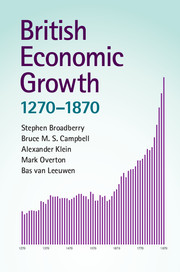Prologue: Historical national income accounting
Published online by Cambridge University Press: 05 January 2015
Summary
Gross Domestic Product (GDP) is the single most widely employed measure of the value of a country’s market-based economic activity, as GDP per head is of relative and absolute levels of prosperity, and annual rates of change in GDP per head are of the pace of economic growth. GDP has its flaws (it omits non-market activity and leisure, and captures changes and differences in quality, especially of services, imperfectly) but has the merit of being widely understood and respected (Leunig, 2011: 358). There is no alternative single measure that does the same job more effectively. That is why today many governments make their own estimates of GDP per head based upon official statistics of economic output and population and why the United Nations, World Bank and other organisations publish annual estimates ofGDP andGDP per head for most of the world’s economies, including many for which only the most rudimentary economic and demographic data are available. It is these estimates that inform contemporary debates about the pace of economic growth, widening gap between rich and poor countries, and progression of countries from underdevelopment to development. Obtaining a proper historical perspective on these issues is more problematic, for governments took little interest in the gathering of official statistics before the nineteenth century and the first attempts to measure GDP followed some time later. It has therefore devolved upon historians to rectify this deficiency, drawing upon a range of mostly unofficial data sources.
- Type
- Chapter
- Information
- British Economic Growth, 1270–1870 , pp. xxxi - xlPublisher: Cambridge University PressPrint publication year: 2015
- 1
- Cited by



